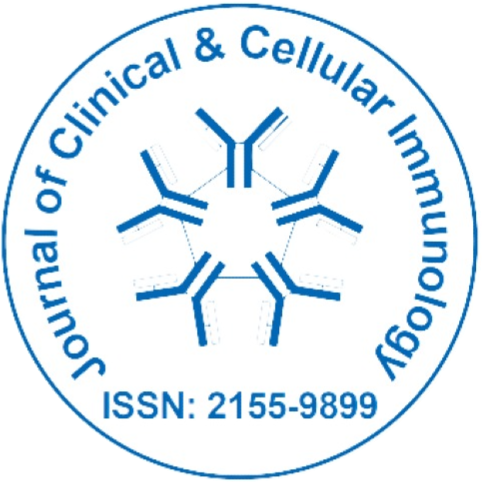
Journal of Clinical and Cellular Immunology
Open Access
ISSN: 2155-9899

ISSN: 2155-9899
Commentary - (2024)Volume 15, Issue 1
Allergy immunology discusses into the intricate relationship between the immune system and allergic reactions. It investigates how the body's defense mechanisms can sometimes misinterpret harmless substances as threats, activating allergic responses. This field plays a crucial role in diagnosing, managing and preventing allergies, offering insights into the complex interplay of immune cells, antibodies and allergens.
The basics of allergic reactions
Allergies occur when the immune system reacts abnormally to substances that are typically harmless, such as pollen, dust mites, pet dander, certain foods or medications. These substances, known as allergens, provoke the immune system to produce specific antibodies, primarily Immunoglobulin E (IgE). IgE antibodies bind to mast cells and basophils, which are types of immune cells distributed throughout the body, particularly in tissues that interface with the external environment, like the respiratory and digestive tracts and the skin.
Upon subsequent exposure to the allergen, the IgE antibodies trigger the release of various chemicals, including histamine, leukotrienes and cytokines, from mast cells and basophils. These chemicals cause the characteristic symptoms of allergies, such as sneezing, itching, swelling, hives, wheezing and in severe cases, anaphylaxis.
The role of immunology in allergies
Immunology provides valuable insights into the mechanisms underlying allergic reactions. The study shows how the immune system identifies and responds to allergens, aiming to develop strategies for diagnosing and treating allergies more effectively. Key areas of focus within allergy immunology include:
Allergen recognition: Understanding how the immune system recognizes allergens is fundamental to allergy immunology. Immune cells, particularly dendritic cells, play a crucial role in presenting allergens to other immune cells, initiating the allergic response.
Immune cell activation: Upon allergen exposure, immune cells undergo activation and release various mediators that contribute to allergic symptoms. Mast cells, basophils, eosinophils and T lymphocytes are among the key players in co-ordinating allergic responses.
Inflammatory pathways: Allergic reactions involve complex inflammatory pathways, mediated by cytokines, chemokines and lipid mediators. These pathways modulate the recruitment and activation of immune cells at the site of allergen exposure, amplifying the allergic response.
Immunoglobulin production: The production of allergenspecific IgE antibodies is a identification of allergic sensitization. Understanding the mechanisms underlying IgE production and regulation is critical for developing targeted therapies to mitigate allergic reactions.
Diagnostic approaches in allergy immunology
Allergy immunologists employ various diagnostic techniques to identify allergens and assess allergic sensitization in patients. These include:
Skin prick testing: This widely used diagnostic method involves applying small amounts of allergen extracts to the skin and observing for localized allergic reactions, such as redness and swelling.
Serum IgE testing: Blood tests can measure allergen-specific IgE antibodies circulating in the bloodstream, providing valuable information about allergic sensitization.
Challenge tests: In certain cases, challenge tests may be performed under medical supervision to confirm suspected allergies by exposing patients to small amounts of allergens and monitoring their responses.
Component-Resolved Diagnostics (CRD): CRD identifies specific protein components within allergens, allowing for more precise diagnosis and characterization of allergic sensitization patterns.
Treatment strategies in allergy immunology
Treatment strategies in allergy immunology aim to alleviate symptoms, prevent allergic reactions and modulate the immune response. These may include:
Allergen avoidance: Identifying and avoiding allergens is the fundamentals of allergy management. Environmental control measures, dietary modifications and lifestyle adjustments can help reduce allergen exposure.
Medications: Antihistamines, corticosteroids, decongestants and leukotriene receptor antagonists are commonly used to relieve allergic symptoms and inflammation.
Allergen Immunotherapy (AIT): AIT, also known as allergy shots or sublingual immunotherapy, involves administering gradually increasing doses of allergens to desensitize the immune system and reduce allergic responses over time.
Biologic therapies: Biologic agents targeting specific immune pathways, such as monoclonal antibodies against IgE or cytokines, are emerging as promising treatments for severe allergic conditions.
Future directions in allergy immunology
Advances in allergy immunology continue to move innovation in allergy diagnosis, treatment and prevention. Ongoing study efforts focus on elucidating the molecular mechanisms of allergic sensitization, developing novel immunomodulatory therapies and exploring the role of the microbiome in allergic diseases.
Furthermore, personalized approaches to allergy management, guided by individual patient profiles and immune signatures, hold great assurance for improving treatment outcomes and enhancing patient quality of life.
Allergy immunology represents a dynamic and rapidly evolving field at the intersection of immunology, allergology and clinical medicine. By resolving the complexities of allergic reactions and immune dysregulation, allergy immunologists strive to advance our understanding of allergic diseases and improve patient care through innovative diagnostic and therapeutic strategies.
Citation: Kumar A (2024) Allergy Immunology in Defense Mechanisms and Allergic Responses of Harmful Substances. J Clin Cell Immunol. 15:705.
Received: 23-Jan-2024, Manuscript No. JCCI-24-29439; Editor assigned: 26-Jan-2024, Pre QC No. JCCI-24-29439 (PQ); Reviewed: 09-Feb-2024, QC No. JCCI-24-29439; Revised: 16-Feb-2024, Manuscript No. JCCI-24-29439 (R); Published: 23-Feb-2024 , DOI: 10.35248/2155-9899.24.15.705
Copyright: © 2024 Kumar A. This is an open-access article distributed under the terms of the Creative Commons Attribution License, which permits unrestricted use, distribution, and reproduction in any medium, provided the original author and source are credited.